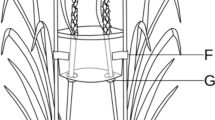Summary
Honey bee workers are able to nurse or to destroy and thus to recognize the capped queen cells containing a pupa. Fatty acid esters, especially methyl oleate, methyl palmitate and ethyl oleate were found in significant amounts on the queen pupal cuticle. Methyl oleate, the major component, along with smaller amounts of methyl linoleate and methyl linolenate, were involved in the recognition of queen cells by workers. In natural conditions of the colony, queen cells containing a paraffin pupal lure with methyl oleate were accepted 5.9 days by workers, releasing about 1.8 queen pupa equivalents during that period, when control cells (without ester) were kept only 2.1 days. Although these esters are non specific to honey bees, they are of great importance in social regulation of the honey bee colony.
Similar content being viewed by others
References
Bergström G, Löfqvist J (1970) Chemical basis for odour communication in four species ofLasius ants. J Insect Physiol 16:2353–2375
Cassier P, Lansky Y (1992) Structure et rôle social de quelques glandes exocrines à sécrétion phéromonale chez l'abeille domestiqueApis mellifera L (Hymenoptera: Apididae). Ann Biol 2:61–95
Free JB (1967) Factors determining the collection of pollen by the honeybee foragers. Anim Behav 15:134–144
Free JB, Williams IH (1975) The effect on the foraging behaviour of honeybees of the relative locations of the hive entrance and brood combs. Appl Anim Ethol 2:141–154
Free JB, Winder ME (1983) Brood recognition by honeybee (Apis mellifera) workers. Anim Behav 31:539–545
Free JB, Ferguson AW, Simpkins JR (1989) The effect of different periods of brood isolation on subsequent brood-cell visits by workers honeybees (Apis mellifera L.). J Apic Res 28:22–25
Huang ZY, Otis GW (1991) Inspection and feeding of larvae by worker honey bees: effects of starvation and food quantity. J Insect Behav 4:305–317
Jay SC (1963) The development of honeybees in their cells. J Apic Res 2:117–134
Koeniger N (1978) Das Wärmen der Brut bei der Honigbiene. Apidologie 9:305–309
Koeniger N, Veith HJ (1983) Glyceryl-1,2-dioleate-3-palmitate, a brood pheromone of the honeybee (Apis mellifera). Experientia 39:1051–1052
Le Conte Y (1990) Contribution à l'étude des relations Abeilles-Varroas: approches comportementale, chimique, et génétique. Thesis, Université de Paris XI, Orsay, France
Le Conte Y, Arnold G, Trouiller J, Masson C, Chappe B, Ourisson G (1989) Attraction of the parasitic miteVarroa to the drone larvae of honey bees by simple aliphatic esters. Science 245:638–639
Le Conte Y, Arnold G, Trouiller J, Masson C, Chappe B (1990) Identification of a brood pheromone in honey bees. Naturwissenschaften 77:334–336
Le Conte Y, Sreng L, Trouiller J, Poitout S (1993) Method for altering worker bee behaviour with brood pheromones. Patient WO 93/25070
Lensky Y, Slabezki Y (1981) The inhibitory effect of the queen bee (Apis mellifera L.) footprint pheromone on the construction of swarming queen cups. J Insect Physiol 27:313–323
Myser WC (1952) Ingestion of eggs by honey bee workers. Am Bee J 92:67
Page RE, Erickson EH (1984) Selective rearing of queens by worker honey bees: kin or nestmates recognition. Ann Entomol Soc Am 77:578–580
Pain J (1961) Sur la phéromone des reines d'abeilles et ses effets physiologiques. Ann Abeille 4:73–152
Post DC, Mohamed MA, Coppel HC, Jeanne RL (1984) Identification of ant repellent allomone produced by social waspPolistes fuscatus (Hymenoptera: Vespidae). J Chem Ecol 12:1425–1799
Rickli M, Guerin PM, Diehl PA (1992) Palmitic acid released from honeybee worker larvae attracts the parasitic miteVarroa jacobsoni on a servosphere. Naturwissenschaften 79:320–322
SAS Institute Inc. (1985) SAS User's Guide: Statistics, Version 5, Cary, SAS Institute Inc. N.C.
Sato M, Kuwahara Y, Matsuyama S, Suzuki T (1993) Chemical ecology of astigmatid mites XXXVII. Fatty acid as food attractant of astigmatid mites, its scope and limitation. Appl Entomol Zool 28:565–569
Thiery D, Le Quere JL (1991) Identification of an deterring pheromone in the eggs of the European corn borer. Naturwissenschaften 78:132–133
Thiery D, Gabel B, Farkas P, Pronier V (1992) Identification of an oviposition-regulating pheromone in the European grapeline moth,Lobesia botrana (Lepidoptera: Tortricidae). Experientia 48:697–699
Trouiller J (1993) La communication chimique inter- et intra-specifique chez l'abeille. Thesis, Université de Paris VII, Paris, France
Trouiller J, Arnold G, Le Conte Y, Masson C, Chappe B (1991) Temporal pheromonal and kairomonal secretion in the brood of honeybees. Naturwissenschaften 78:368–370
Trouiller J, Arnold G, Chappe B, Le Conte Y, Masson C (1992) Semiochemical basis of the infestation of honey bee brood byVarroa jacobsoni. J Chem Ecol 11:2041–2053
Vinson SB, Frankie GW, Blum MS, Wheeler JW (1978) Isolation, identification, and function of the Dufour gland secretion ofXylocopa virginica texana. J Chem Ecol 4:315–323
Visscher PK (1986) Kinship discrimination in queen rearing by honey bees (Apis mellifera). Behav Ecol Sociobiol 18:453–460
Vuillaume M (1959) Nouvelles données sur la psychophysiologie de l'élevage des reines chezApis mellifica. Ann Abeille 2:113–138
Winston ML, Slessor KN, Willis LG, Naumann K, Higo HA, Wyborn MH, Kaminsky LA (1989) The influence of the queen mandibular pheromones on worker attraction to swarm clusters and inhibition of queen rearing in the honey bee (Apis mellifera L.). Insectes Soc 36:15–27
Winston ML, Higo HA, Slessor KN (1990) Effect of various dosages of queen mandibular gland pheromone on the inhibition of queen rearing in the honey bee (Hymenoptera: Apidae). Ann Entomol Soc Am 83:234–238
Author information
Authors and Affiliations
Rights and permissions
About this article
Cite this article
Conte, Y.L., Sreng, L., Sacher, N. et al. Chemical recognition of queen cells by honey bee workersApis mellifera (Hymenoptera: Apidae). Chemoecology 5, 6–12 (1994). https://doi.org/10.1007/BF01259967
Issue Date:
DOI: https://doi.org/10.1007/BF01259967




